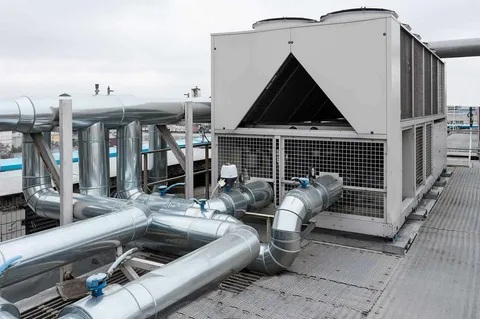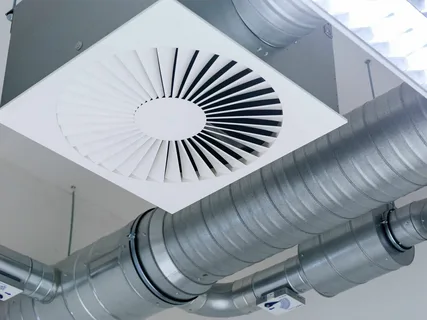As we go about our daily lives, an often-overlooked hero is working tirelessly behind the scenes to ensure our well-being and comfort – air ventilation systems. These unsung heroes are crucial in maintaining indoor air quality, regulating temperature levels, and creating a healthy, inviting environment for all occupants. In this deep dive into air-ventilation, we will explore the importance of proper ventilation systems, the critical components of a practical setup, the benefits of investing in quality solutions, and much more. Join us on this journey to uncover the invisible hero that is air-ventilation.
The Importance of Proper Air-Ventilation Systems
Maintaining Indoor Air Quality is essential for creating a healthy indoor environment. Proper air-ventilation systems are crucial in circulating fresh air and removing contaminants, reducing the risk of respiratory issues and allergies. In addition to this, a well-maintained ventilation system can help control the spread of airborne diseases and improve overall well-being.
Controlling Indoor Humidity Levels is another important aspect of indoor air quality. Effective air-ventilation systems help regulate moisture levels, preventing mound growth and the buildup of harmful toxins. This is crucial for ensuring a comfortable and safe indoor environment and preventing structural damage to buildings and furniture. Maintaining optimal humidity levels can save on repair and replacement costs in the long run.
Proper ventilation contributes to a healthier indoor environment and creates a more pleasant living or working environment. This can promote productivity and overall satisfaction among occupants. With the right ventilation system, you can enjoy better air quality, humidity control, and, ultimately, a happier and healthier indoor space.
 Understanding the Role of Air Circulation in Indoor Spaces
Understanding the Role of Air Circulation in Indoor Spaces
Air circulation is critical to maintaining a comfortable and healthy indoor environment. Efficient air circulation is essential for distributing fresh air throughout a space, ensuring that occupants can breathe easily and enjoy high indoor air quality. In addition to providing fresh air, proper air circulation also helps to expel stale air and odors, creating a more pleasant atmosphere within a building. Proper air circulation plays a crucial role in regulating temperature levels within a building. By circulating air effectively, heating and cooling systems can operate more efficiently, helping to maintain a consistent and comfortable temperature throughout the space.
This not only improves the comfort of occupants but also helps to reduce energy costs associated with heating and cooling. Air circulation is crucial to maintaining a healthy and comfortable indoor environment. By ensuring that fresh air is consistently distributed throughout a space and temperature levels are appropriately regulated, occupants can enjoy a space that is both comfortable and conducive to their well-being.
Critical Components of an Effective Air-Ventilation System
Air filters are an integral component in keeping indoor air quality. They play a crucial role in trapping dust, pollen, and other harmful particles that can affect our air. Regular maintenance and replacement of these filters are necessary to ensure the HVAC system functions optimally. Properly installed ductwork is essential for efficient air circulation throughout the home. This helps prevent energy wastage and ensures that the air quality remains at its best. High-quality fans can further enhance the system’s performance, thereby improving the overall indoor air quality.
Properly positioned air vents are also necessary as they help distribute fresh air evenly throughout the space while preventing the buildup of stagnant air. Regular cleaning of these vents is necessary to ensure efficient air circulation. Maintaining the HVAC system is crucial to its efficiency and effectiveness. Regular cleaning and upkeep of the system can go a long way in ensuring it operates smoothly. Proper insulation in the home is another crucial factor contributing to energy efficiency and indoor air quality.
Benefits of Investing in Quality Air ventilation Solutions
Investing in quality air ventilation solutions can significantly impact significantly impact the overall indoor environment. Here are some key benefits:
- Improved Indoor Air Quality:Quality air-ventilation systems help to remove pollutants and contaminants from the air, ensuring a healthier living or working environment.
- Reduced Respiratory Issues:By filtering out allergens, dust, and other harmful particles, quality air-ventilation systems can help reduce the risk of respiratory problems and allergies.
- Enhanced Energy Efficiency:Quality air-ventilation systems can improve energy efficiency by ensuring proper airflow, reducing the workload on heating and cooling systems, and lowering utility costs over time.
Common Issues with Poor Air-ventilation and How to Address Them
Indoor air pollution is a significant concern that can impact the health and well-being of occupants in a home or building. Poor air-ventilation can lead to a buildup of pollutants, such as dust, pet dander, and volatile organic compounds (VOCs), which can negatively affect indoor air quality. To address this issue, it is crucial to regularly clean air filters, ducts, and vents to remove contaminants and improve the overall air quality within the space. Inadequate air-ventilation can create moist environments that promote mold growth.
Mold growth not only poses health risks but can also damage the structure of the building. To prevent mound growth, it is essential to ensure proper ventilation in areas prone to moisture buildups, such as bathrooms and basements. Installing exhaust fans and dehumidifiers can help control humidity levels and reduce the risk of mound growth. Poor air-ventilation can result in discomfort for occupants due to stuffy, stale air and uncomfortable indoor temperatures. To improve air circulation and enhance comfort levels, consider using ceiling fans, opening windows for natural ventilation, and investing in a whole-house air-ventilation system to promote better airflow.
Maximizing Energy Efficiency with Smart Air-Ventilation Practices
Innovative air-ventilation practices are crucial in maximizing energy efficiency in indoor spaces. By implementing the following strategies, you can reduce energy consumption and lower utility costs:
Use Programmable Thermostats
Programmable thermostats allow you to set specific temperature levels based on your schedule, ensuring that your air-ventilation system operates only when necessary. This can help optimize energy usage and prevent unnecessary heating or cooling of your space.
Optimize Airflow Patterns
You can create efficient airflow patterns that promote better air circulation and temperature regulation by strategically placing fans and air vents. Proper airflow can help distribute fresh air evenly throughout the space, reducing the need for constant heating or cooling.
Invest in Energy-Efficient Components
When upgrading or installing air-ventilation systems, opt for energy-efficient components such as high-efficiency fans and motors. These components consume less power while maintaining optimal air quality, leading to long-term energy savings.
Schedule Ventilation Appropriately
Adjusting ventilation schedules based on occupancy levels and outdoor conditions can help prevent unnecessary energy consumption. Implementing an intelligent scheduling system can ensure that your air-ventilation system runs efficiently only when needed.
Adopting these innovative air-ventilation practices can enhance energy efficiency in your indoor spaces while promoting a comfortable and healthy environment for occupants.
The Impact of Air Quality on Health and Productivity
Poor air quality is a pressing issue that can profoundly impact the health and well-being of individuals in indoor spaces. When contaminants, dust, or allergens pollute the air, it can lead to many respiratory problems, such as asthma and allergies. These health issues affect individual’s quality of life and can result in increased absenteeism and reduced productivity among building occupants. Additionally, the presence of stale and stagnant air can create a sense of discomfort and fatigue, further hindering productivity levels.
It is crucial for building owners to prioritize the implementation of quality air-ventilation systems and regularly maintain them to ensure good air quality. Doing so can create a healthier and more conducive environment for individuals to thrive in and maximize their potential. Taking proactive measures to improve air quality can lead to a more productive and fulfilling work or living space for all occupants. In today’s fast-paced world, where individuals spend a significant amount of time indoors, the importance of good air quality cannot be overstated.
Individuals need to be able to breathe clean, fresh air to maintain their health and well-being. By addressing the issue of poor air quality, building owners can create a space that promotes overall wellness and productivity. Poor air quality can also hurt the environment, contributing to pollution and climate change. Building owners can reduce their carbon footprint and contribute to a healthier planet for future generations by implementing quality air-ventilation systems and sustainable practices.
Innovations in Air-Ventilation Technology for Sustainable Living
As sustainability continues to gain importance in our daily lives, the role of innovative air-ventilation technology in promoting environmentally-friendly practices is becoming more significant than ever. These advancements contribute to enhancing energy efficiency and play a crucial role in reducing overall carbon footprints in residential and commercial spaces.
One of the critical advancements in air-ventilation technology is the integration of intelligent sensors. These sensors can detect air quality, humidity, and occupancy patterns within a given space. By precisely monitoring these parameters, smart sensors can optimize ventilation systems to operate more efficiently and effectively, ultimately leading to a healthier indoor environment.
Energy-recovery systems represent another groundbreaking innovation in air-ventilation technology. These systems facilitate the exchange of heat between incoming and outgoing air streams, significantly reducing the amount of energy required to heat or cool indoor spaces. This improves energy efficiency and leads to lower utility costs, making it a win-win solution for both the environment and consumers.
Conclusion
In conclusion, proper air ventilation systems are vital in maintaining indoor air quality, promoting a healthy environment, and increasing energy efficiency. Understanding the importance of air circulation, critical components of practical systems, and the impact of air quality on health and productivity are essential factors in ensuring a comfortable and safe indoor space. By investing in quality air-ventilation solutions and staying up-to-date with innovative technologies, individuals and businesses can create sustainable living spaces that benefit both occupants and the environment.
FAQs
How does air ventilation impact indoor air quality?
Air ventilation is crucial in maintaining good indoor air quality by continuously circulating fresh air and removing pollutants, allergens, and odors from indoor spaces. Proper ventilation helps to dilute and eliminate contaminants, improving overall air quality and creating a healthier environment for occupants.
What are the critical components of an adequate air-ventilation system?
Critical components of an adequate air-ventilation system include air filters, ductwork, fans, and air vents. Air filters help to trap dust, pollen, and other particles, while ductwork distributes air throughout the space. Fans promote air circulation, and air vents allow for indoor and outdoor air exchange.
Can improved air-ventilation help reduce the spread of airborne illnesses?
Yes, improved air-ventilation can help reduce the spread of airborne illnesses by diluting and removing contaminated air. Proper ventilation can decrease the concentration of viruses, bacteria, and other pathogens in indoor spaces, reducing the risk of airborne transmission and promoting a healthier environment for occupants.
| Other Good Articles to Read |
| Blogs-Nation |
| Blogs-Peoples |
| Bryan Smith Blogs |
| intellect blogs |
| the fault in our blogs |
| blogs eu |
| oz forums |
| recruitment blogs |
| zet blogs |
| id blogs |
| Blog Studio legale |
| blogs map |
| Related Business Listings |
| Contact Directory |
| Local Business Profiles |



